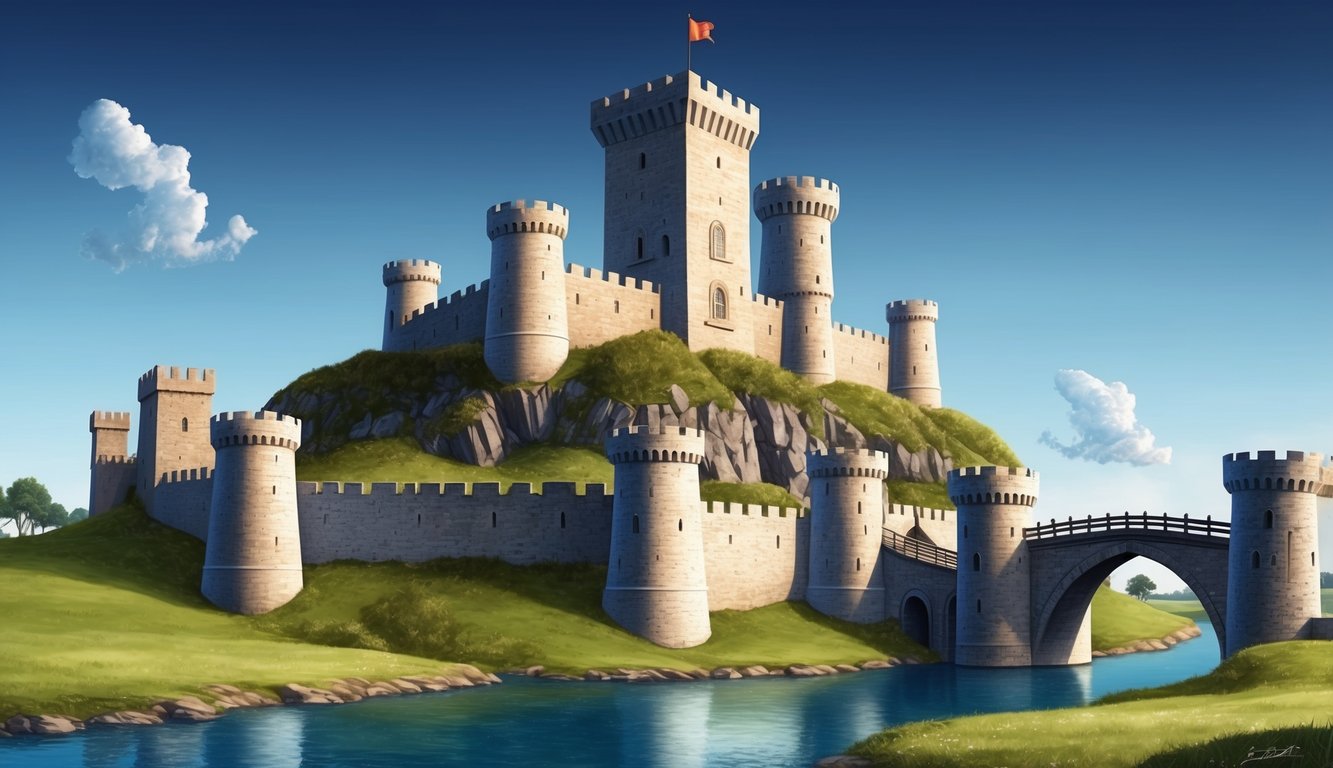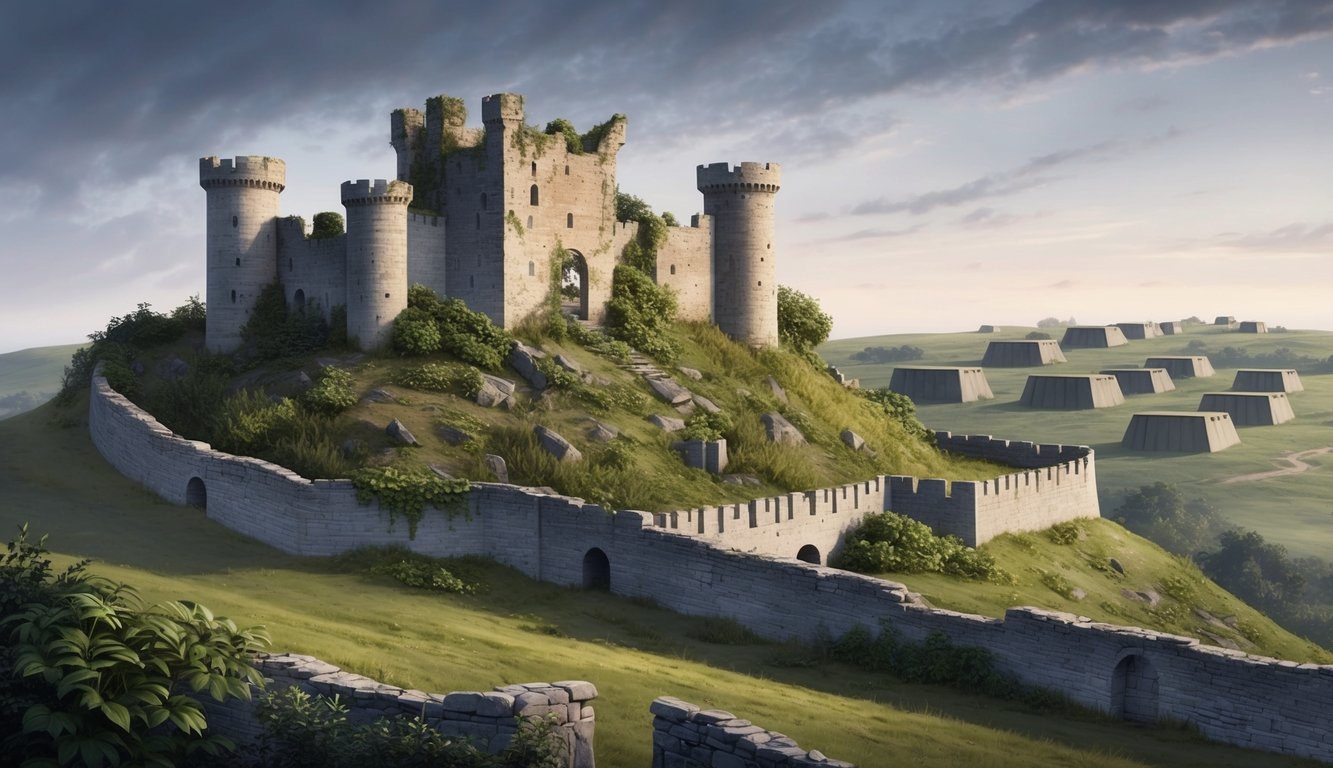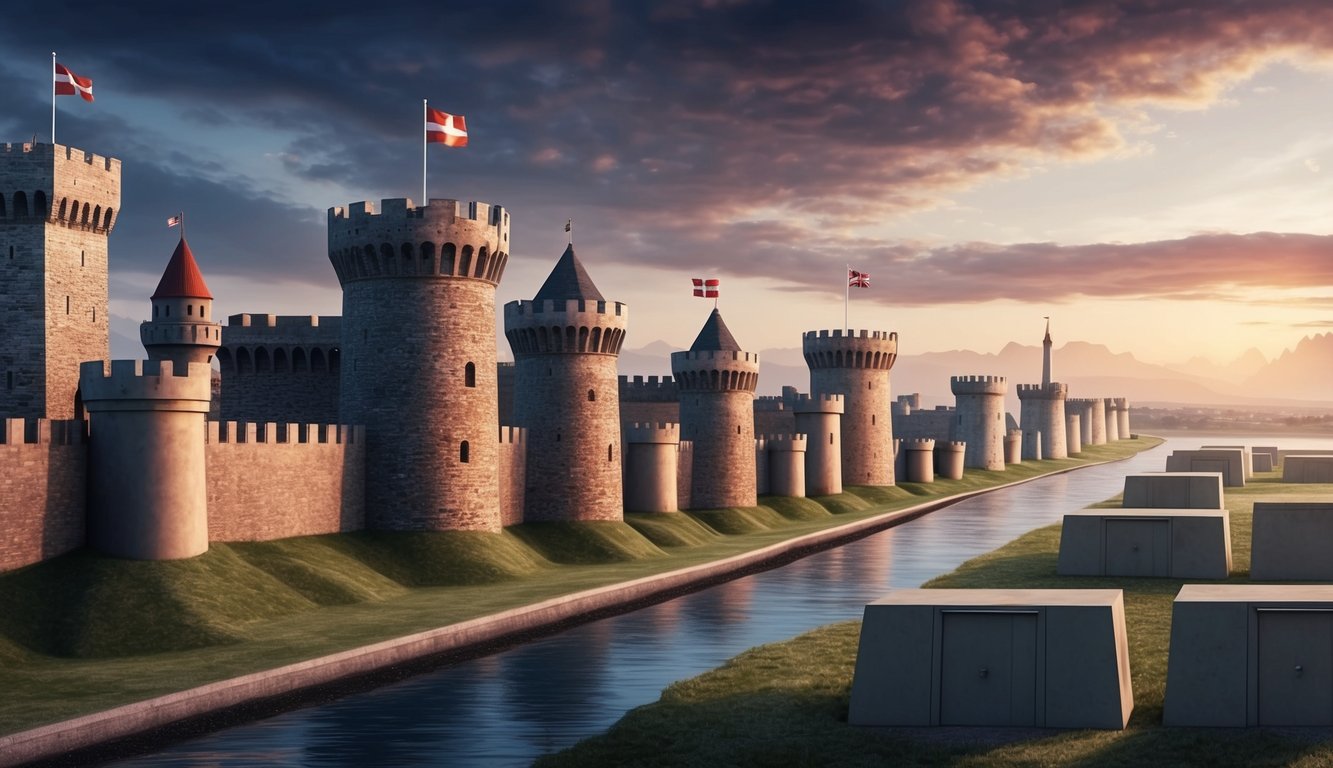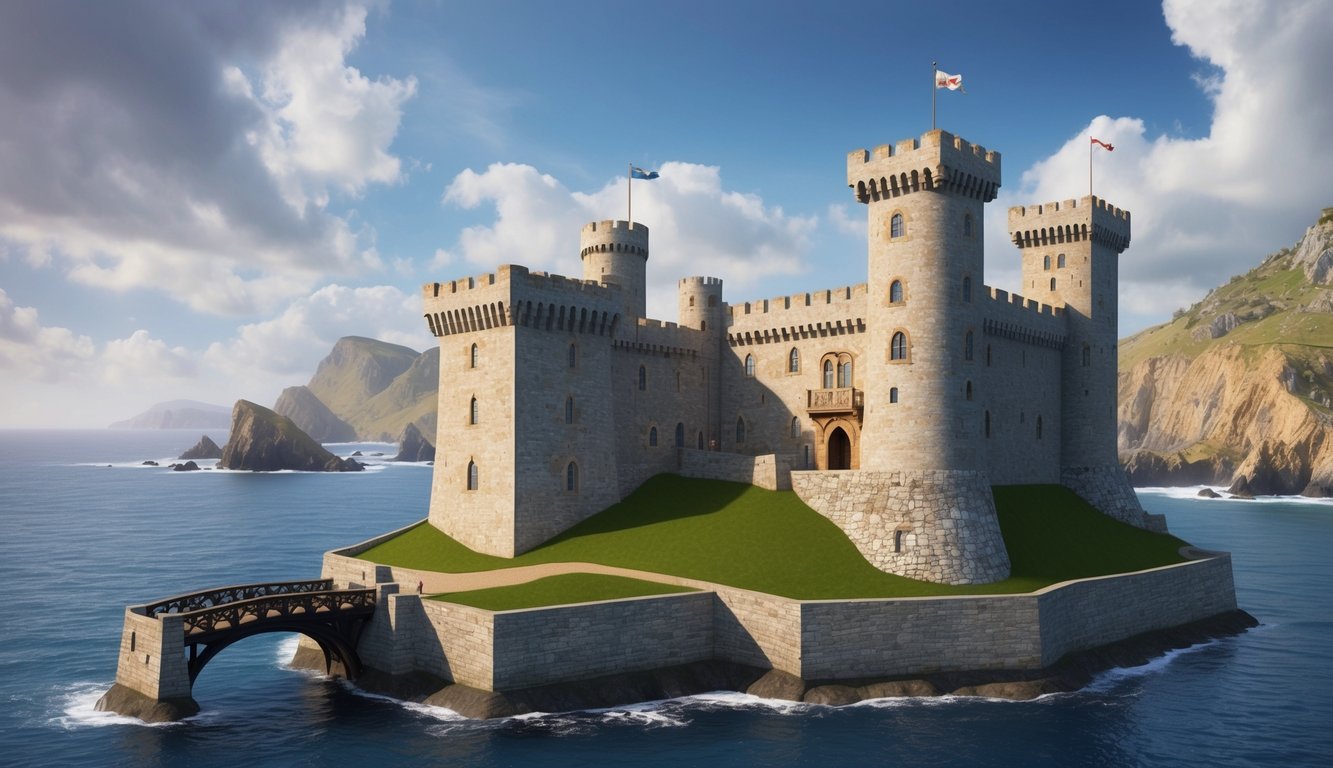Military fortifications have significantly influenced the course of human history, evolving in tandem with civilization.
From ancient ramparts to medieval castles and contemporary bunkers, these defensive structures have been pivotal to military strategy for thousands of years. Diving into the intriguing realm of fortifications reveals their profound impact on warfare, politics, and cultural evolution throughout the centuries.
The narrative of military fortifications is one characterized by persistent innovation and adaptation.
With the evolution of weapons and tactics, the designs and functions of these defensive structures also transformed.
Early fortifications were typically simple earthworks or wooden barriers, whereas later examples showcased intricate stone architectures, ornate castle designs, and, ultimately, reinforced concrete bunkers capable of enduring modern artillery assaults.
Key Takeaways
- Military fortifications have transitioned from basic earthworks to intricate defensive systems, mirroring advancements in military technology.
- Castles functioned as both defensive bastions and political power centers during the medieval era.
- Contemporary fortifications remain essential to military strategy, utilizing state-of-the-art materials and design methodologies.
Early Beginnings of Fortifications

Fortifications have been integral to human societies since ancient times, evolving from basic earthworks to sophisticated walled cities as combat techniques advanced.
Ancient Fortification Techniques
In prehistoric eras, you might have encountered rudimentary fortifications like ditches and wooden palisades that safeguarded settlements.
As the Bronze Age unfolded, fortification methods became more sophisticated, with stone walls commonly constructed from tightly fitted large blocks.
Notably, the ancient Egyptians excelled at creating vast defensive walls, using thick mud bricks encircling their cities and temples.
These walls often featured sloped sides to thwart potential attackers.
By the Iron Age, fortification techniques saw significant advancements, including the development of stone towers and gatehouses, which offered superior vantage points and controlled city access.
Famous Ancient Fortifications
One of the most ancient fortifications known is the Walls of Jericho, dating back to approximately 8000 BCE, which protected one of the earliest cities in history.
In ancient Egypt, another remarkable fortification was the fortress of Buhen, constructed during the Middle Kingdom.
It included formidable walls and a moat that safeguarded Egypt’s southern frontier for centuries.
Another striking example is the Mycenaean citadel of Tiryns in Greece, whose massive “cyclopean” walls, constructed with enormous limestone boulders, still stand as a testament to Bronze Age engineering excellence.
Medieval Fortifications and Castles
Medieval fortifications and castles were critical defensive structures that defined warfare and society throughout the Middle Ages.
These formidable strongholds served as power centers, protection, and focal points of military strategy.
Design and Structure of Medieval Castles
Medieval castles evolved from basic wooden constructions into intricate stone fortresses.
They were typically situated on elevated terrain for enhanced visibility and defense.
The motte-and-bailey design was an early variant, featuring a wooden keep on an earth mound (motte) encircled by an enclosed courtyard (bailey).
With advances in stone construction, castles became increasingly complex, often featuring thick concentric walls for additional fortification.
Towers provided advantageous positions for archers, enabling defenders to engage attackers from various angles.
The great hall served as the heart of the castle, where the lord conducted affairs and entertained guests.
Living spaces, storerooms, and workshops were commonly integrated within the castle walls.
Key Features of Castles
Castles were equipped with numerous defensive features designed to repel attackers:
- Moats: Water-filled ditches encircling the castle
- Drawbridges: Retractable bridges over moats
- Portcullises: Heavy iron gates that could be swiftly lowered
- Arrow loops: Narrow openings allowing archers to shoot
- Battlements: Protective parapets with gaps for defenders
The keep, the castle’s most fortified section, served as the ultimate line of defense and the residence of the lord.
Siege Warfare in the Medieval Era
Sieges were a prevalent strategy for capturing well-fortified castles.
Attackers would encircle the stronghold, cutting off supplies and striving to breach its defenses.
Siege tools included:
- Battering rams for gate demolition
- Trebuchets for hurling stones at walls
- Siege towers for scaling fortifications
Defenders countered with boiling oil, rocks, and arrows, while relying on stored supplies to outlast their besiegers.
Castles were built to endure extended sieges, often featuring wells and substantial food reserves.
Advancements in Military Fortifications
Military fortifications experienced significant transformation as new technologies and tactics emerged, continually reshaping defensive systems and strategies, which would influence warfare for generations.
Rise of Star Forts and Vauban Fortifications
Star forts represented a major advancement in defensive architecture.
Their angular designs provided improved coverage of the surrounding area, significantly reducing blind spots.
These buildings featured low, thick walls designed to withstand artillery fire.
Vauban fortifications advanced this design concept further.
Sébastien Le Prestre de Vauban, a noted French military engineer, refined the art of star-shaped defenses.
His intricate designs encompassed systems of bastions, ravelins, and glacis, yielding exceptionally effective fortifications that typically required extensive sieges to conquer.
Introduction of Gunpowder and Artillery
The advent of gunpowder altered the landscape entirely.
Suddenly, once-impenetrable stone walls became susceptible to formidable projectiles.
Castles and cities hurriedly adapted their defense strategies.
Artillery necessitated a complete re-evaluation of fortification architecture.
Walls became lower and thicker to better absorb impacts.
Engineers devised angled surfaces to redirect incoming fire.
Defenses now needed to protect against both traditional siege methods and the devastating effects of artillery strikes.
With the emergence of rifled artillery, the competition between offense and defense escalated.
Fortifications became more intricate, incorporating underground bunkers and dispersed defensive points to evade increasingly precise targeting.
Fortifications in the Modern Era
Modern military fortifications have undergone extensive changes in response to cutting-edge weaponry and tactics.
You’ll observe how trenches and underground facilities have become essential to safeguard against increasingly destructive attacks.
World War I and Trench Warfare
Trench warfare defined combat on the Western Front during World War I. Soldiers excavated extensive trench networks for protection against enemy fire, forming zigzag lines that extended for miles, offering multiple defense layers.
These trenches included firing positions, dugouts, and machine gun placements.
Barbed wire, along with minefields, further secured the approaches.
Communication trenches connected the front lines to rear support areas.
Despite their protective features, trenches provided little comfort, exposing soldiers to mud, disease, and constant artillery threats.
Troops rotated among front, support, and reserve trenches to alleviate the burden.
The Inception of Bunkers and Underground Forts
As artillery grew increasingly powerful, military engineers began constructing bunkers and underground forts using concrete and steel to provide necessary protection.
The Maginot Line exemplifies this trend, an extensive French defensive system featuring a network of bunkers, gun placements, and living quarters constructed underground.
Bunkers were typically designed with thick walls, reinforced blast doors, and air filtration systems to sustain entire garrisons for prolonged durations.
During the Cold War, even more sophisticated underground facilities emerged, designed to endure nuclear assaults while maintaining military readiness.
Innovations in Defensive Systems
Throughout history, military fortifications have evolved dramatically, incorporating technological advancements and adapting to shifting threats.
These innovations have transformed defensive strategies and systems.
Evolution of Forts in the Cold War Era
During the Cold War, defensive structures adapted to address nuclear threats, including vast underground bunkers built to withstand atomic detonations.
The Berlin Wall became a potent symbol of division, characterized by its guard towers and extensive “death strip,” creating a formidable barrier.
Missile silos emerged as pivotal components of defense systems.
These hardened installations safeguarded intercontinental ballistic missiles, thereby forming a fundamental aspect of nuclear deterrent strategies.
Radar stations and early warning systems became integral to defense infrastructures, providing critical minutes for potential attack preparations.
Technological Advancements in Fortification
Modern fortifications utilize leading-edge technology to enhance security.
You might observe smart materials designed to better absorb blast impacts than conventional concrete.
Perimeter security relies heavily on sensor networks that detect potential intruders using methods ranging from motion sensors to thermal imaging cameras.
Active defensive measures have transformed protection protocols against projectiles, enabling systems to intercept incoming missiles or ordinance before impact.
Many fortified positions incorporate electronic warfare capabilities, enabling disruption of enemy communication and guidance systems from within.
Furthermore, 3D printing is transforming fortification construction, allowing for swift deployment of defensive sites in remote or challenging terrains.
Legacy and Preservation

Military fortifications have significantly influenced history, redefining landscapes and cultures around the world.
Their lasting presence stands as a testament to human creativity and the ever-shifting nature of warfare.
Historical Significance
The impact of military fortifications reaches beyond their initial defensive roles.
The Great Wall of China stands as a monumental symbol of national identity and engineering mastery.
These structures provide crucial insights into historical societies, technological advancements, and military strategies.
Despite being temporary, field fortifications and entrenchments have profoundly shaped battle outcomes throughout history.
Their remnants can be found across former battlefields, offering tangible connections to pivotal moments in military history.
Conservation and Tourism
Preserving fortifications carries unique challenges and opportunities.
Numerous fortresses have been transformed into museums or cultural hubs, enabling visitors to engage with history.
Conservation initiatives not only protect architectural heritage but also bolster local economies through increased tourism.
Visitors can explore well-preserved castles, bunkers, and city walls that attract millions yearly, offering immersive experiences ranging from guided tours to historical reenactments.
By visiting these fortifications, you contribute to their preservation and gain a deeper understanding of the strategic minds that built them.
Frequently Asked Questions

Military fortifications have been pivotal throughout history, their designs and effectiveness evolving in line with advancements in military technology and strategies.
Why did the construction of fortifications play a crucial role in colonial times?
Fortifications were essential for colonial powers seeking to establish and maintain control over new territories, providing protection for settlers, securing trade routes, and serving as bases for further expansion.
They also showcased military strength to deter potential threats and indigenous resistance.
At what point in history did castles no longer serve as effective defense structures?
Castles began to become less effective as primary defense structures in the late 15th and early 16th centuries, as the widespread adoption of gunpowder weapons, particularly cannons, rendered traditional castle walls vulnerable to bombardment.
What fortification holds the title of the oldest in the world?
The city walls of Jericho are recognized as the oldest known fortifications, dating back to around 8000 BCE.
Archaeological excavations have uncovered these walls that once protected one of the earliest settled communities.
Can you explain the main differences between a military fortress and a castle?
A military fortress primarily focuses on defense and military strategy, often serving as a base for troops and equipment.
In contrast, castles, while defensive, were also residences for the nobility and centers of local governance.
How did the introduction of cannons impact the usefulness of castle defenses?
Cannons revolutionized the approach to siege warfare and castle design.
Their destructive power made traditional high and narrow walls ineffective, prompting designers to develop lower, thicker walls and star-shaped fortifications to better withstand cannon fire.
Which fortification is known to be the largest ever constructed?
The Great Wall of China is recognized as the largest fortification ever built, extending over 13,000 miles.
Construction and reconstruction of the wall took place over many centuries to safeguard Chinese territories from nomadic invasions.

